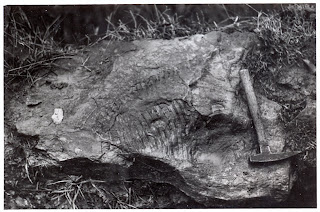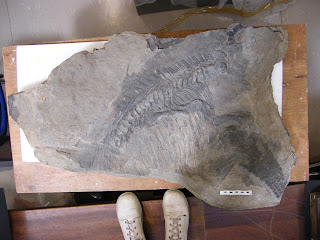Sometimes, analyses don’t give you the results you are
expecting. Sometimes that is down to
human error – but at other times it is simply because the model you have
in your head is wrong.
 |
| The slab as originally found, near Chia Gara,
Amadia. |
Take the new ichthyosaur published in Biology Letters today, Malawania
anachronus. It was discovered in
1952 by British petroleum geologists working in Iraq – walking down a mule track,
they were engaged in an argument, when one of them happened to look down at the
slab of rock that he was standing on.
Dragged into position to dam a small river, the block (right) contained the
remains of an ichthyosaur, consisting of some skull remains, much of the
postcranial skeleton, and critically including significant pectoral girdle
material. As this was the only
ichthyosaur known from the Middle East, the geologists realised its importance,
and brought it back with them to (what is today called) the Natural History
Museum (London). There, it came to the
attention of Robert Appleby, who up to the early 1970s was the only person
working on ichthyosaurs in Britain.
 |
Robert Appleby's original text figure of the
skull region, submitted for his
description. |
Appleby was fascinated by the specimen – it had been
recorded at the museum as Lias (Early Jurassic) in age, but he recognised it as
having an archaic form, and wondered if it might actually be Late
Triassic. He started his investigations
around the end of 1974, contacting members of the original survey team, in an
attempt to constrain the age of the specimen, and identify which formation the
slab could have come from. Over the next
4 years, the authorities who had worked in the region told him repeatedly that
the Triassic in that area was barren of fossils, and it must have come from the
Jurassic Sargelu Formation. As Appleby
prepared his manuscript to submit to the journal Palaeontology in summer of 1979, he sent photographs of some isolated
pollens from the block to the Cambridge
palynological authority Norman Hughes, asking him if he could determine
whereabouts in the Jurassic sequence the specimen could have come from. He got an unexpected reply.
Hughes queried whether he had received the correct images,
as the samples from the ichthyosaur block clearly indicated a Cretaceous
(probably pre-Aptian) age.
 |
Some of the images of the 1979 sampled
palynomorphs that led Norman Hughes
to identify their source as undoubtedly
Early Cretaceous. |
This just did
not fit with what Appleby was expecting at all.
He had been told by one of the geologists that the Cretaceous beds were
some distance away from the locality where the slab was found, and (in somewhat
derogatory terms) that the local people simply would not have expended the
effort required to transport the slab that far.
Hughes attempted a further sample from the block, but this time could
only obtain organic residue. Appleby
appears to have decided that the first sample had in some way become confused,
and with Hughes’ second sample proving inconclusive, abandoned further
palynological attempts at dating the slab.
Instead, he tried to pursue the age of the slab based on invertebrate
fossils in the area….in effect, he was becoming distracted into trying to
determine the age of the local geology, rather than the slab containing the
ichthyosaur.
Appleby eventually had his paper accepted for Palaeontology in the late eighties –
provided he could tick one final box: resolve the age of the specimen. Busy working on his massive monograph of the
ichthyosaurs, he decided to leave the Iraq specimen (which he had planned
to call Iraqisaurus kurdistanensis)
until his monograph was completed.
Sadly, he died only five days after he had written the last pages, some
years later, so never returned to work on the date for the Iraq ichthyosaur.
When I came across this unresolved work in his
archives, I determined to try to complete the journey of this publication (and
others). The first thing that I did was
take a new sample
.JPG) |
The slab NHMUK PV R6682 in July 2007, prior to
matrix being
resampled for pollen/spores/dinoflagellates. White boots for scale. |
from the slab (left) – although it first of all yielded the organic
residue that Hughes had obtained, further processing by Steve Brindley and
James Riding (BGS) yielded a sample whose pollen/spore assemblage perfectly
matched Hughes’ assessment over thirty years earlier: Early Cretaceous
(specifically, late Hauterivian-Barremian).
At this point, I approached Valentin Fischer (a specialist on Early
Cretaceous ichthyosaurs) to join Darren Naish on writing duties. Fischer was a perfect choice, as he was not
only familiar with the development of literature and new specimens over the
last twenty years (and the changes to our understanding of ichthyosaur
relationships), but he had already seen signs that the end Jurassic extinction
had not been quite so rough an experience for ichthyosaurs as had previously
been thought. As such, he was not
trapped in the orthodox mindset that only a very few closely-related
ichthyosaurs (all members of Ophthalmosauridae – a family Appleby was extremely
familiar with) actually made it through to the Cretaceous. It is conclusively not a member of that
family (lacking all derived features), and structures of its scapula and
forepaddle clearly show it to be archaic, as recovered time and again from our analyses. It is – if
you like – a fossilised ‘living
fossil’: when the coelacanth was recovered off the coast of South Africa in the early twentieth
century, it was thought to have been extinct for more than 70 million years. So finding Malawania almost 70 million years after it was thought to be
extinct is a similar surprise. And just
as that one specimen was incontrovertible evidence of the survivial of the
coelacanth, so this single specimen is also true of the survival of Malawania’s kind.
There is a certain unity to the assessment of the specimen
by Appleby, and Fischer’s work: both recognised the specimen as unusually
‘archaic’ in its morphology. Fischer,
however, was neither constrained by poor advice from local ‘experts’ on the
limitations of the age, nor by a narrow view of the diversity of taxa that made
it through the Jurassic-Cretaceous extinction. Not all ichthyosaur workers
might find it so easy to move on with this very necessary paradigm shift, being
‘stuck in the past’ very much as Malawania’s
skeletal anatomy was.
But they will have to – because there are more specimens to
come.
 |
At
left, Malawania, the Jurassic-style Cretaceous ichthyosaur from Iraq;
at
right, fellow Jurassic extinction survivor
Acamptonectes.
|
Guest post by Jeff Liston, Co-Author, Yunnan Key Laboratory for Palaeobiology, Yunnan University, Kunming, Yunnan Province, People’s Republic of China.


